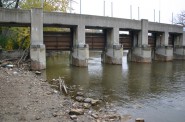Repairing Estabrook Dam Will Cost Less
When all costs are considered, removing the dam could cost far more than repair.
One of the key arguments repeatedly made in favor of destroying the Estabrook Dam is that it will cost significantly less than to repair it – in particular, if future operation and maintenance costs are factored into the cost analysis.
Fiscal prudence was cited by County Executive Chris Abele in his veto of a budget amendment that added $750,000 for a fish passage to be constructed as part of the repair alternative supported by the County Board. The higher costs for repair were similarly cited by the Milwaukee Metropolitan Sewerage District (MMSD), the Village of Shorewood, and the City of Milwaukee in resolutions supporting removal of the dam. But is it possible all are wrong?
The cost argument appears to have crystallized following the issuance in September 2014 of a draft Environmental Assessment (EA) report that included a capital and operating costs for what were identified as three feasible alternatives: repair with provisions for fish passage; dam removal; or construction of a rock ramp. As no group seems to advocate the rock ramp alternative, the costs that matter (and were cited in a least a dozen articles in the Milwaukee Journal Sentinel) are the estimated $1.7 million for removal versus $5.1 million for repair (making the repair alternative exactly three times more costly). The costs for repair include $1.6 million for repair plus another $900,000 for construction of a fish passage plus $2.6 million for 20 years of operation and maintenance.
A slightly updated analysis of costs was presented in a summary of the EA prepared in February 2015 for submittal as evidence in the court case.
| Summary of Costs as Presented in the Environmental Assessment Report for the Primary Repair and Removal Alternatives for the Estabrook Dam | |||||
| Alternative | Capital Costs | Annual O&M Costs | 20 Years of O&M Costs | Present Worth of 20 Years of O&M Costs | Estimated Total Present Worth Costs |
| 1 – Dam Repair | $1,660,000 | $160,000 | $3,200,000 | $2,616,000 | $4,276,000 |
| 1A – Dam Repair w/ Fish Passage | $2,518,000 | $160,000 | $3,200,000 | $2,616,000 | $5,134,000 |
| 2 – Dam Removal | $1,674,000 | $0 | $0 | $0 | $1,674,000 |
The estimated cost for repair has been further increased during 2015. In June, the estimate of capital costs for repair was increased by $627,000, in response to an updated inspection of the dam which found additional deterioration (since the date of the last inspection in 2010). Costs for the fish passage component have also increased from the $858,000 estimate submitted to the court in February. Costs of $1.35 million were cited in a June 15th letter to the court; $1.107 million in an Environmental Impact Report submitted to the Wisconsin DNR on October 8th With no adjustments having been made in the estimate for removal, the repair alternative would appear to now be at least 3.5 times greater than removal.
One aspect of previous news coverage is that there seemingly has been no critical review (and very limited detail) provided regarding the cost estimates. Only one of 15 articles regarding the dam in the Milwaukee Journal Sentinel published between August 24, 2014 and May 18, 2015 bothered to break out the cost for construction of the fish passage separately from primary costs associated with repair of the dam.
The debate earlier this year over the costs associated with the proposed Milwaukee Bucks arena provides an example of the importance of understanding the assumptions underlying any cost estimate for a contentious, publicly-funded project. The cost estimates for the Estabrook Dam repair and removal alternatives were one of the first items to draw my attention in reviewing the EA.
Operations and Maintenance Costs
As shown on the table above, a majority of costs attributed to the repair alternative are associated with long-term operations and maintenance (O&M) costs. An estimate of $160,000 first appeared in the draft EA report published in September 2015. The O&M costs are a source of significant contention with members of MIlwaukee River Preservation Association, which cites $10,000 as the high end for annual costs based on an informal survey they conducted of other dam operators in Wisconsin. The high costs appear to have been driven by several assumptions, the most important of which was that the county would have the equivalent of at least one full time employee assigned to monitoring the dam on a daily basis. The O&M costs as presented in Attachment 9 of the draft EA are provided below.
Operations and Maintenance Cost Estimates for Dam Alternatives

O&M costs for three dam alternatives (1A – Repair w/ Fish Passage; 2 – Removal; 4 – Replacement of Gated Section with a Rock Ramp) as presented in the draft EA.
The lack of detail here is striking given that this represents a majority of costs associated with the repair alternative, and also formed the basis (at least in part) for the resolutions passed by MMSD, the City of Milwaukee, and the Village of Shorewood. No narrative or footnotes were provided in Attachment 9 of the EA regarding the basis for the O&M costs, but all appear to be approximate costs rounded to the nearest $5,000, 10,000 or $20,000.
In the revised cost estimate submitted by the county to the court in June 2015, the total O&M costs have remained the same, but the composition of the costs changed and as summarized below.
| Estimated Future Annual Operation and Maintenance Costs for the Estabrook Dam | ||
| Item | Description | Annual Budgeted Cost |
| 1 | Labor | $50,000 |
| 2 | Fringe benefits | $17,500 |
| 3 | Debris removal | $50,000 |
| 4 | Repairs | $30,000 |
| 5 | River flow monitoring and computer related costs | $12,500 |
| TOTAL | $160,000 | |
| Reference: Letter from Milwaukee County to Paul Kuglitsch, dated June 15, 2015 |
Based on the inclusion of item 4, the cost is probably more accurately described as an estimate of annual Operation, Maintenance, Monitoring and Repair (OMM&R) costs.
The need for a full-time employee warrants a greater level of critical analysis. So does the $50,000 estimated annual cost for debris removal, which arguably is a cost that would be shifted to other local governments if large floating debris that is now captured in part behind the spillway was instead carried downstream into the navigation channels heavily used by recreational boaters in the downtown and Milwaukee Harbor. As the O&M costs may be the key remaining issue in the next court hearing (now scheduled for June 2016), the public would benefit from further scrutiny of the key assumption related to O&M costs.
It’s also worth noting (and hasn’t been reported) that the county has established a maintenance trust fund for the dam that receives $51,000 in rental income per year from television towers located in Lincoln Park, and which will have a balance of over $300,000 by 2017 when dam operations could resume.
Excluded Costs
While the arguments related to costs for O&M (or OMM&R) relate to costs that are included in current cost estimates, other arguments relate to costs that are currently excluded from these estimates. For the repair alternative, examples of additional costs that are currently excluded from the primary cost estimates could include: (a) interest on capital costs (if money is borrowed by the County to complete the repairs), (b) future major costs (not covered by the $30,000 per year for repairs now included in the OMM&R budget), and (c) the costs for flood insurance (more on this issue in the next installment).
For removal, some examples of potential costs excluded from the current $1.7 million dam removal estimate include: (a) costs for Glendale to modify at least 30 stormwater outfalls that discharge to the Milwaukee River that are designed for the higher water level associated with the impoundment; (b) costs for private landowners to repair dockwalls and removal docks and other boat infrastructure; and (c) costs for environmental restoration of land formerly covered by impoundment waters but now exposed.
The former Woolen Mills Dam on the Milwaukee River in West Bend (removed in 1988), is actually presented in one of the reference documents cited in the EA as an example of a dam where the removal cost was estimated at $82,000, but where an additional $2.3 million was eventually spent on restoration costs (including “engineering design, grading, seeding, channel work, fisheries improvements, construction of a new bridge, and development of a park over 61 acres of the former impoundment”). The repair cost had originally been estimated at $3.3 million or 40 times the cost for removal, while the final cost differential ended up being only 1.4 times greater cost for repair than for the full removal project (including restoration).
In short, the excluded costs of the dam removal option would appear to warrant further public scrutiny.
Article Continues - Pages: 1 2
A Freshwater Controversy
-
The Path Forward for Estabrook Dam
 Feb 10th, 2016 by David Holmes
Feb 10th, 2016 by David Holmes
-
Estabrook Dam’s Environmental Impact
![Photograph of fish passing through the fish passage at the Mequon-Thiensville Dam. As of June 2015, a total of 35-species of fish have been recorded by a “fishcam” in the act of swimming past the dam [http://www.co.ozaukee.wi.us/1248/Fishway-Camera]).](https://urbanmilwaukee.com/wp-content/uploads/2016/01/image03-185x122.jpg) Jan 17th, 2016 by David Holmes
Jan 17th, 2016 by David Holmes
-
Does the Estabrook Dam Cause Flooding?
 Dec 30th, 2015 by David Holmes
Dec 30th, 2015 by David Holmes
















Considering the majority of these properties are located in Glendale and Glendale receives most of the property tax revenue; it’s obvious that Glendale should be stepping forward to preserve their tax base.
Let them pay for the benefits they receive. Milwaukee County should pay the cost of removal and nothing further. If there’s still a funding gap, too bad.
The County originally messed with the natural order of things with good intentions. Putting it simplistically, “They broke it so they bought it.” Glendale being the primary beneficiary is not true. As an amenity available to residents from anywhere it seems the community at large benefits and therefore must share in the costs.
At a time when all the world is trying to repair the damages of man-made threats to the environment, it amazes me that any serious credence can be given to this selfish effort to repair the dam. All the dams on the Milwaukee River need to be removed. None of them serve any indispensable purpose any longer.
What is more important, allowing a very few wealthy landowners a view of a pond in their backyards or allowing lake sturgeon and other native species to return to their habitat? Economically won’t it be better to have the river become a recreational and sport fishing jewel all along it’s length rather than a feeble, stunted portion that cannot sustain it’s own populations?
When doing your analysis of the price premium, wouldn’t it be more useful to use a percentage increase premium vs a total dollar since the value of Mequon property maybe worth more or less than the Glendale property?
It seems like there is roughly a 35% increase in the value per acre for upstream properties. I would be interested, and I think it would be more useful, to decrease the Glendale properties by 35% and use this number as the price adjustment.
I wonder how the recreational canoeing activities upstream of the dam area would vary under either of the 2 scenarios. I imagine perhaps limited seasonal usage under the dam removal option- possibly only dangerous early spring river running with better early summer/late spring canoeing and varied to no river canoeing during the dry summer time. With the dam repaired- possibly a consistent type of small lake and pond meandering until one canoed further upstream beyond Lincoln park.
Ha yes….pretentious Eastsiders and Riverwesters want their view of whats good and disregarding what the lower classes want. They forget to think about the thousands of people from west of the park that use and used to fish the park. Lets get rid of the dam so richer fly fisherman can live their romantic visions closer to home.
Haha, I love the snark about the pretentious Eastsiders & Riverwesters. They should just shut up & pay for lake access for a nearby, relatively wealthy suburb.
You tell em’ Casey.
Interesting articles, Mr. Holmes. Thanks for writing.
Your figures are intriguing. I love good data and evidence. Curious, when the impoundment was “permanently” lowered, did the adjacent properties see an additional 35% drop in value relative to those homes not adjacent to it?
To the dam removal crowd, since when do we attribute all costs of a park-like feature to those most immediately adjacent to it? I thought parks and park-like features, such as the impoundment, were the domain of the county at large. I can’t think of another county park amenity that was assessed to the adjacent property owners. Frankly, both sides need to remember this for this discussion and others.
Yes, Lincoln Park is in Glendale but the vast majority of people who use the park are from west of the park in Milwaukee. Will the dam increase Glendale property value? Yes. And that’s what most of this argument seems to be about: those greedy, selfish Glendale-its. People forget about all the nearby Milwaukee residents that use the park too.